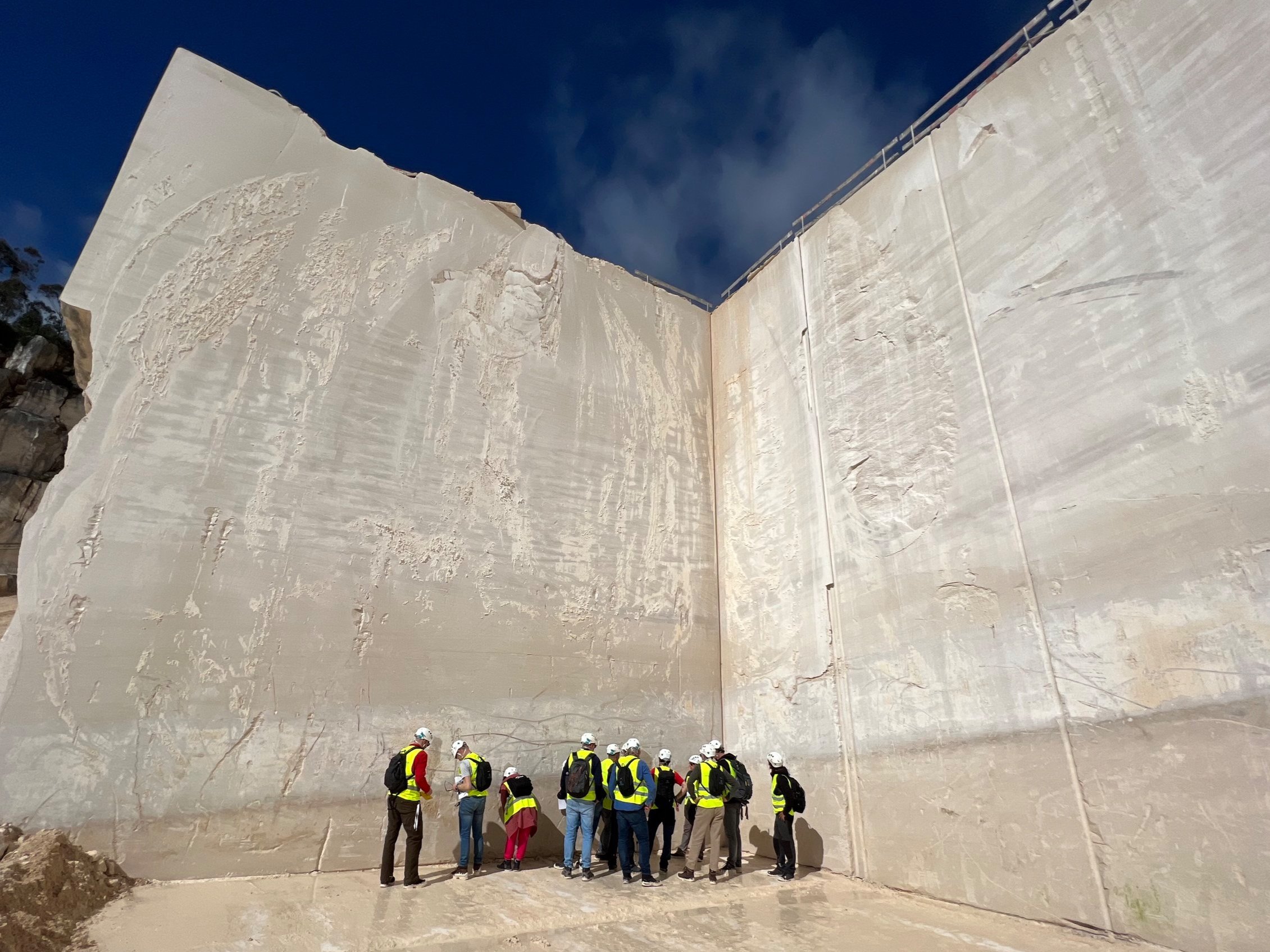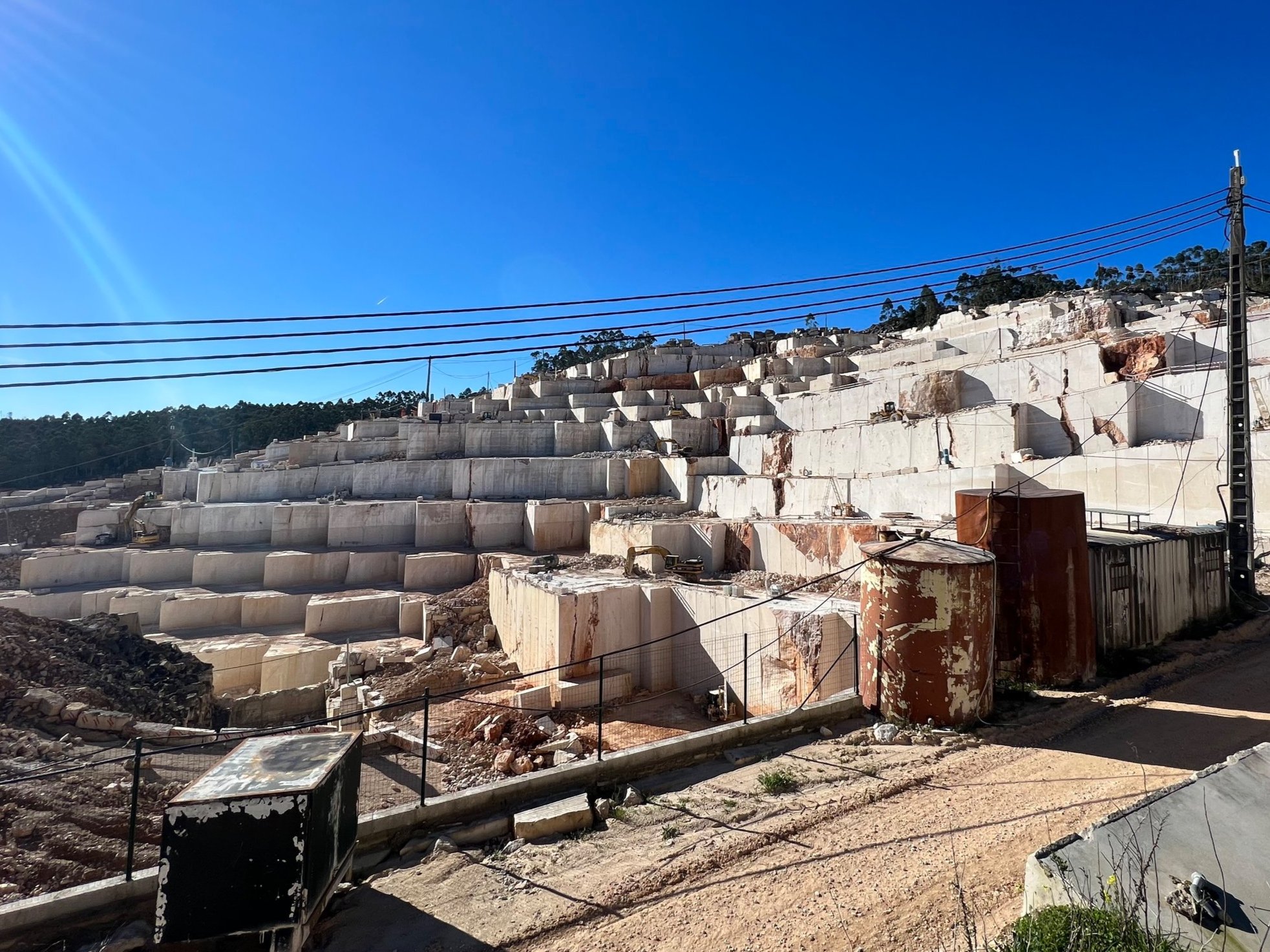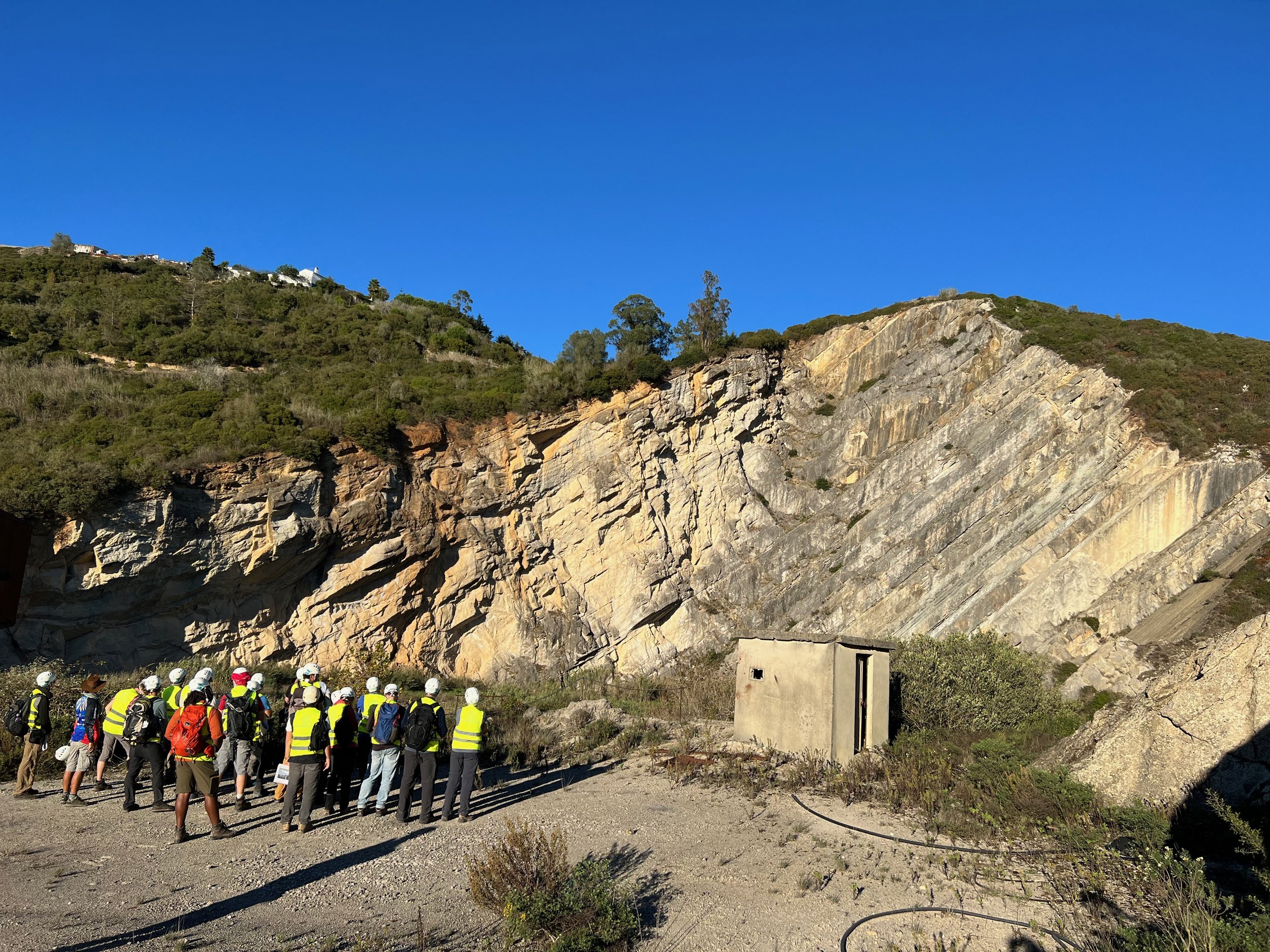Carbonate depositional systems and Interaction with Salt Structures (lusitanian Basin, portugal)
Implications of halokinesis on carbonate depositional systems, reservoir properties, source rock distribution, trap geometry and seal properties.
(On-demand field-based training course)
Introduction
This 5 day field trip focuses on understanding how to recognise different carbonate facies and the way these change when interacting with salt tectonics.
Participants will observe in the field structural and sedimentary features that are usually only visible on seismic and/or drill cores. The outcrops will be compared with seismic examples from Lusitanian and Peniche Basins, perfect to understand tectono-sedimentary structures at different scales, while allowing to discern sub-seismic scale features that are only visible on outcrop.
This field-based course will take place in the Lusitanian Basin (Portugal), particularly in its central part, located in the central coastal Portuguese region between Peniche, Serra de Aire - Candeeiros and Pedrogão.
The Lusitanian basin located on the Atlantic West Iberian Margin present world-class exposures that are ideal to visualize common aspects and problems that professionals deal with during exploration, appraisal, and development phases of hydrocarbon accumulations and for underground energy storage (natural gas, hydrogen, compressed air, battery systems, etc…), CCUS, geothermal energy and toxic /nuclear waste storage. Several outcrops, including quarries, coastal and mountain exposures will be observed.
The main field trip goals are:
Observe in detail carbonates successions from different types of environments and their main characteristics on outcrop, from distal to inner facies associations of Middle Jurassic and Upper Jurassic sequences;
Understand the paleogeographic and environmental variability of the Jurassic sedimentary sequences in the Lusitanian Basin;
Observe the interaction between carbonates and salt structures, in particular diapirs.
Observe implications on source rocks distribution and potential to generate hydrocarbons.
Observe implications on reservoir properties modelling of hydrocarbon accumulations, CCS and energy storage.
Observe implications on trap geometry and seal integrity.
Lagoonal to peritidal carbonate sequence at Vale de Meios
Reservoir properties variability in high energy facies at Serra dos Candeeiros.
Course Characteristics
Physical requirements: Easy. Participants will be required to walk a maximum of 2 km at some localities over easy relatively flat terrain.
Duration: 5 days
Type: Fieldwork and evening talks. Coastal and inland outcrops and quarries (active or abandoned).
Area: Central Costal Portugal
Target audience: Geologists, Salt Specialists, Structural Geologists, Petroleum Geologists, geophysicists and reservoir engineers with good understanding of carbonate depositional systems and/or reservoir production.
Pre-requisites: Petroleum geology, Carbonate systems, Structural geology and salt tectonic principles
What’s included: Transportation in mini-bus with professional driver, meals, accommodation in 4 star hotel (4 nights) , HSE Assessment and Risk Mitigation Plan, field guide, personal insurance, Personal Protection Equipment (PPE) bag (hard hat, reflective vest, emergency blanket, waterproof whistle) and walking poles (at request).
Number of participants: Minimum of 15 and maximum 20 persons + 3 guides / instructors.
Course Cost: 3800 € (excl. tax). Special discount rates available for EFG - European Federation of Geologists (20%) or APG - Associação Portuguesa de Geólogos members (10%).
Upper Jurassic Sequence at the Sobral da Lagoa quarry on the western flank of Caldas da Rainha - Óbidos Diapir.
Middle Jurassic calcareous debris-flow associated with distal steepening of carbonate ramp.
Instructors
Ana Azerêdo* : Full Professor of the University of Lisbon, at the Geology Department, Sciences Faculty and researcher at the Instituto Dom Luiz (UL). PhD in Geology (Stratigraphy and Palaeontology) and Agregação (Habilitation) from the University of Lisbon. Main expertise on carbonate facies and main research focus on multiscale studies of carbonate systems (facies/microfacies analysis, diagenesis, palaeoenvironmental interpretation, sequence and basinal integration); secondarily, micropalaeontology (Jurassic-Cretaceous benthic foraminifera, calcareous algae). The research crosses Stratigraphy, Sedimentology, Micropalaeontology, Palaeogeography and Petroleum Geology. The Jurassic of the Lusitanian Basin has been the preferential target of her studies, but worked also
on the Cretaceous and outside Portugal. Applications to Petroleum Geology mainly concern carbonate reservoir analysis (namely the Pre-Salt carbonate reservoirs from Brazil and reservoir facies analogues from Portugal) and basin stratigraphy linked to source-rock studies. Has coordinated and participated in several R&D projects, including for O&G industry. Participated by invitation in 2 Advanced Courses on Carbonate Reservoir Geo Engineering for Galp/ Petrobras. Supervised several PhD and MSc theses. Author/co-author of over 200 publications, among papers in international indexed journals and in other journals, books/book chapters, Proceedings of Scientific Meetings and other.
Pedro Barreto: Founder of Geo Logica, graduated in Geology from University of Lisbon and MSc in Tectonics, Royal Holloway, University of London. Former Senior Structural Geologist at CGG NPA Satellite Mapping and Senior New Ventures & Exploration Geologist at Partex O&G where he was Lead Project Geologist for Portuguese exploration. Expert in structural geology from rifting to compressional settings with research and fieldwork in Portugal, Africa, Middle East and South America. Co-author of several publications and presentations on rifting and salt tectonics and implications on exploration, development and exploitation of natural resources for energy production and storage.
Ricardo Pereira: Assistant Researcher at GeoBioTec (Univ. Nova Lisboa) and Researcher/External collaborator at Instituto Dom Luiz (Univ. Lisboa). Graduated in Geology from Lisbon University, MSc in Stratigraphy and Sedimentology at Lisbon University and PhD from Cardiff University, developing research on the evolution of passive continental margins, salt tectonics and subsurface energy storage. With over 22 years experience in the O&G industry, Ricardo has worked as regional exploration geologist for PARTEX Oil and Gas, and Petroleum Development Oman, contributing to world class discoveries in major salt provinces, including the discovery of pre-salt Santos Basin, the Oman salt provinces and offshore Angola.
*(Instructor participation subjected to availability)
Pliensbachian to Toarcian distal carbonate ramp to outer to middle submarine fan calciturbidites.
High angle fault affecting Pliensbachian deep marine limestones, marls and black shales at Portinho da Areia do Norte.
MAIN TOPICS COVERED ON FIELD TRIP
Timing of diapirism and its relation with tectonic events;
Salt diapirism and interaction with sediments: differences and similarities between carbonate and clastic overburden interactions;
Different types of carbonate environments and their main characteristics on outcrop;
Paleogreographic distribution of carbonates in relation with salt structures;
Source rocks distribution in carbonate systems and potential to generate hydrocarbons;
Reservoir & seal properties changes in carbonate systems;
Internal structure of diapirs (layered evaporites, volcanic intrusions, interbedded carbonate and clastic sediments, folding, boudinage, faulting and shear zone development in evaporites);
Fault and salt welds and fluid flow along weld;
Unconformities: J-hook, flap-onlap, low-angle wedge;
Cap rock formation and dissolution breccias around salt structures;
Hydrocarbon trap geometries against salt diapirs;
Structural inheritance and onset of halokinesis;
Salt-sediment interface controlling fluid flow;
Fluid flow through salt;
Reworked breccias from diapiric material and roof sediments;
Roof collapse and sedimentary infill above diapirs;
Reservoir damage around salt diapirs;
Implications of field work observations for seismic imaging and interpretation of carbonate environments around salt structures.
Field Trip Program
Day 1
-
Departure from Lisbon Airport (8:30 am)
Fórnea
Vale de Florido
Lunch at Pé da Pedreira
Vale de Meios
Vale de Ventos
Hotel Alcobaça
-
Serra dos Candeeiros and Planalto de Santo António (Stops 1 to 4)
Theme: Transect across carbonate depositional environments from basinal to lagoon.
Panoramic perspective of an outer-ramp to shallow water sequence at Fórnea Creek.
Lagoonal to peritidal facies at Vale de Meios.
Brine well with shadoof in the centre of Rio Maior Salt extraction flats at Marinhas de Sal.
Day 2
-
Serro Ventoso
Portela das Salgueiras
Lunch at Vale de Ventos
Salinas de Rio Maior
Sogerela gypsum mine
Hotel Alcobaça
-
Serra dos Candeeiros, Planalto de Santo António and Óbidos.
Theme: High-energy carbonates variability, production geology and well performance. Carbonates and evaporitic depositional systems
High energy facies reservoir modelling at Serro Ventoso area (check excavators for scale).
High energy facies (including tempestites) and lagoonal facies at Arrimal Area.
Day 3
-
Praia de Pedrogão
Praia Pedras Negras
Praia da Concha
Lunch at Praia Paredes de Vitória
Mina do Azeche
Nazaré headland
Hotel Alcobaça
-
Pedrogão to Nazaré
Theme: Source rocks, diapirs and associated sedimentation.
Middle Jurassic-Late Jurassic unconformity at Pedrógão Beach.
Oil impregnated folded dolomitic black shales within an abandoned quarry at São Pedro de Moel Diapir, Praia das Pedras Negras.
Slumped Lower Jurassic carbonates caused by downslope sliding off the western flank of the São Pedro de Moel diapir.
Day 4
-
Baleal
Portinho da Areia do Norte
Ponta do Trovão
Lunch at Cabo Carvoeiro
Praia da Consolação
Sobral da Lagoa
Evening presentation
Hotel at Alcobaça
-
Peniche and Óbidos Area
Theme: Slope to outer-shelf deposits, source rocks, diapirs and associated sedimentation.
Middle Jurassic calcareous debris-flow associated with distal steepening of carbonate ramp.
Toarcian GSSP Golden Spike on distal carbonate ramp to outer to middle submarine fan calciturbidites at Ponta do Trovão.
Wedged composite Upper Jurassic carbonate sequence on the western flank of Caldas da Rainha - Óbidos (CdRO) Diapir (CdRO)
Day 5
-
Alcobaça Monastery
Óbidos Castle Section
Arrival to Lisbon Airport
-
On the last day participants will visit Early Gothic style Cistercian monastery at Alcobaça established in 1153 which presents excellent masonry of Serra do Candeeiros limestones.
The field trip will end at Óbidos moorish castle where it is possible to observe the intra-salt carbonate stringers along the Caldas da Rainha - Óbidos (CdRO) diapiric salt wall.
Cistercian Early Gothic Alcobaça Monastery built from Serra do Candeeiros limestones
Óbidos Castle built on Hettangian intra-salt dolomitic stringers.
References
Azerêdo, A. C., Inês, N., Bizarro, P. (2020). Carbonate reservoir outcrop analogues with a glance at pore-scale (Middle Jurassic, Lusitanian Basin, Portugal). Marine and Petroleum Geology, 111, 815-851, available online 23 August 2019. https://doi.org/10.1016/ j.marpetgeo.2019.08.034
Azerêdo, A. C. (2015). Análise de reservatórios carbonatados em afloramento (Bacia Lusitânica) e outros aspectos aplicados à exploração petrolífera. Livro-guia, Módulo “Trabalho de campo na Bacia Lusitânica", Curso de Formação Avançada em Geo-Engenharia de Reservatórios Carbonatados, FCUL/Galp/Petrobras, 64 p. ISBN: 978-989-20-5833-7.
Azerêdo, A. C., Silva, R. L., Duarte, L. V., Cabral, M. C. (2010). Subtidal stromatolites from the Sinemurian of the Lusitanian Basin (Portugal). Facies, 56, 211-23.0
Azerêdo, A. C. (2007). Formalização da litostratigrafia do Jurássico Inferior e Médio do Maciço Calcário Estremenho (Bacia Lusitânica). Comunicações Geológicas, 94, 29-51.
Azerêdo, A. C., Ramalho, M. M. (2005). The Jurassic Geological Heritage at the Parque Natural das Serras de Aire e Candeeiros (Central Portugal): selected examples from a broad spectrum. In: Henriques, M. H., Azerêdo, A. C., Duarte, L. V., Ramalho, M. M. (Eds): Jurassic Heritage and Geoconservation in Portugal: selected sites. Field trip guidebook (Excursion C), IV International Symposium ProGEO on the Conservation of the Geological Heritage, Braga,17-22.
Azerêdo, A. C., Cabral, M. C. (2004). Bio-sedimentary signatures of high-frequency salinity/subaerial exposure changes: examples from the Oxfordian of Portugal (Cabaços Formation). Rivista Italiana di Paleontologia e Stratigrafia, 110, 1, 231-238.
Azerêdo, A. C., Duarte, L. V., Henriques, M. H., Manuppella, G. (2003). Da dinâmica continental no Triásico aos Mares do Jurássico Inferior e Médio. Cadernos de Geologia de Portugal, Instituto Geológico e Mineiro, Lisboa, 43 pp., 7 ests.
Azerêdo, A. C., Wright, V. P., Ramalho, M. M. (2002). The Middle-Late Jurassic forced regression and disconformity in central Portugal: eustatic, tectonic and climatic effects on a carbonate ramp system. Sedimentology, 49 (6), 1339-1370.
Azerêdo, A. C. (1988). Calcareous debris-flow as evidence for a distally steepened carbonate ramp in West-Central Portugal. Comun. Serv. Geol. Portugal, Lisboa, 74, 56-67.
Azerêdo, A. C. (1998). Geometry and facies dynamics of Middle Jurassic carbonate ramp sandbodies, West-Central Portugal. In: V. P. Wright & T. Burchette (eds), Carbonate Ramps. Geological Society, London, Special Pubication., 149, 281-314.
Davison, I., & Barreto, P., (2020). Deformation and sedimentation processes, and hydrocarbon accumulations on upturned salt diapir flanks in the Lusitanian Basin, Portugal. Petroleum Geoscience, DOI: https://doi.org/10.1144/petgeo2019-138
Davison, I., & Barreto, P., (2019). Exhumed Portuguese oil field suggests conjugate potential. GEOExPro, volume 16, no.3 pp. 38-40.
Davison I & Barreto, P. (2019). Salt tectonics and hydrocarbon accumulations trapped on diapir flanks in the Lusitanian Basin, Portugal. Salt Tectonics, Associated Processes, and Exploration Potential: Revisited 1989-2019. GCSSEPM Annual Perkins Rosen Research Conference, Salt Tectonics, electronic files only, p. 300-313.
Duarte, L.V., Silva, R. L., Azerêdo, A. C., Comas-Rengifo, M. J., Mendonça-Filho, J. G. (2022). Shallow-water carbonates of the Coimbra Formation, Lusitanian Basin (Portugal): contributions to the integrated stratigraphic analysis of the Sinemurian sedimentary successions in the western Iberian Margin. Comptes Rendus Géoscience- Sciences de la Planète. In Lézin, C., Saucède, T. (eds), Special Issue Integrated stratigraphy of the Jurassic and the Cretaceous: a tribute to Jacques Rey, 1-18, published online 13 October 2022, https://doi.org/10.5802/ crgeos.144
Duarte, L.V., Silva, R.L., Oliveira, L.C.V., Comas-Rengifo, M.J., Silva, F. (2010). Organic-rich facies in the Sinemurian and Pliensbachian of the Lusitanian Basin, Portugal: Total Organic Carbon distribution and relation to transgressive- regressive facies cycles. Geologica Acta, 8(3), 325–340.
Duarte, L.V., Soares, A.F. (2002). Litostratigrafia das series margo-calcárias do Jurássico Inferior da Bacia Lusitânica (Portugal). Comunicações do Instituto Geológico e Mineiro, 89, 135–154.
Duarte, L.V. (1997). Facies analysis and sequential evolution of the Toarcian-Lower Aalenian series in the Lusitanian Basin (Portugal). Comunicações do Instituto Geológico e Mineiro, 83, 65–94.




















